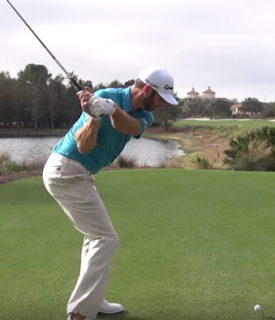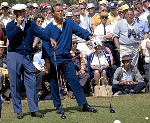|
|
Post by Richie3Jack on Feb 6, 2010 13:43:31 GMT -5
From what I've been told, the S&T was very much based on MOG's pattern for hitting low trajectory wedges. If that's the case, I'm sure it has been tweaked a bit. But, I can understand it because when I started reading the book I remember using a similar pattern from what a teacher instructed me to do when I wanted to hit a low short-iron, but not a knockdown in fear of losing too much distance.
My problem with the S&T is that I don't care for the steep shoulder turn in the backswing becasue I wind up getting steep shoulders in the downswing and the plane line moves too far to the right. It also seems that it's a pattern where you are likely to 'run out of right arm' and I believe in trying to save that right arm for as long as possible.
Now, the S&T guys say that they want the arms straight throughout the swing as much as a golfer reasonably can do that. They also say that it's the 'easiest pattern' to hit the ball correctly. That kind of makes me skeptical because I'm not sure what exactly is their basis of determining the 'easiest'. Furthermore, I get that feeling that 'easiest' pattern may not produce the most optimal results. It's one thing to make things easier lose 20 yards, but hit a nice consistent 5 yard draw. And it's another thing to get a little more complicated, gain 20 yards and hit it dead straight.
I could be wrong on the latter part. I do think the components are valid. But going to ALL of the components and then saying 'it's the easiest pattern to execute' or along those lines makes me wonder what they base that upon.
I really don't have a problem with S&T, but I don't think it's for me. But it's certainly for many other golfers.
3JACK
|
|
|
|
Post by gmbtempe on Feb 6, 2010 17:38:43 GMT -5
I have even less problem with it and like some things about it if I did not lose the distance.
|
|
|
|
Post by hitman119 on Feb 6, 2010 18:17:14 GMT -5
S&T is where I started in July making my swing changes. I can do the S&T swing on the range for the most part, but have trouble playing with it. I actually hit more of a fade on the course (just fits my eye). So I am not really S&T, but use some of the components. I have hit it great since going back to hitting a fade (actually longer).
|
|
|
|
Post by iacas on Feb 9, 2010 1:53:39 GMT -5
They also say that it's the 'easiest pattern' to hit the ball correctly. That kind of makes me skeptical because I'm not sure what exactly is their basis of determining the 'easiest'. Perhaps I could share my opinion for "easiest:" a) your upper center doesn't move, which makes it very easy to deliver the club back to the ball repeatedly because you don't have to time any sliding away or back to the ball. b) your right elbow doesn't lift, so it's very much a one-plane swing, which eliminates the timing of dropping the right elbow back to the side of your rib cage. Your hands and, ideally, the clubhead remain on their plane(s) the entire time. c) the shot pattern is reliable and predictable, with relatively easy to figure out "fault trees." That's all there is to the "simplicity" for me. Mostly a and b, which aren't features of a lot of other swings. Richie, you talked about possibly losing distance - and I don't doubt that you might have - but I know more people who gained distance after switching with a proper instructor. In fact, I don't know of any (admittedly my sample size is 25 people or so) who lost distance working with an S&T instructor. A lot of people, oddly, "switch" and think they've got it in a day, so I've limited this to people who have worked with an instructor. Most gain distance (admittedly, most were hitting over-the-top pull-cuts to begin with, like most golfers :-D). And that's not to say it's for everyone. Some people will naturally find it easier to do something else entirely. "Easier" is subjective, though, and the above is why it's "easier" for me. I can't pretend to speak for Mike or Andy, of course. I have even less problem with it and like some things about it if I did not lose the distance. With whom did you work? It's neither here nor there, but I do wonder if you worked with an instructor or went about it on your own. I'd caution that posed pictures aren't necessarily going to resemble 100% the golfer's actual swing. A lot of the pictures in the book are intended to convey a "feel" to the reader. You'd have done better to use the image on page 85 - an actual swing at impact - than the posed image you took from another page. So, first thing's first, the green line in your image is wrong - the lower center hasn't shifted to the right (nor the upper center to the left), so a proper drawing of the dotted line at that point would connect the two hip sockets instead of the flap of the right pocket and the left front belt loop. The green line would be straight up and down - that's where "stacked" comes from, not just from address. That greatly minimizes the shift you feel is so dramatic - and feel the need to over-emphasize with a posed picture versus one taken from an actual swing. You seem to have the misconception that the spine tilts to the left at the top of the backswing. You excluded a golfer from your hypothetical "back injury" study - I believe it was David Orr. Your reasoning was that he wasn't "leaning to the left" at the top of the backswing, but you seemed to fail to understand that the "leaning left" can't be seen from the face-on view - from that view the spine is vertical, not leaning towards the target. "Left" when rotated 90 degrees is towards the golf ball - from the face-on view the spine remains fairly vertical. If you were down-range, you'd see the side tilting to the golfer's left (again, towards the ball at this point since he's rotated his shoulders 90 degrees). But on to other things... This composite image gives one a good impression of how much the lower body moves in a S&T downswing. The hips moves no more or less than the hips of virtually every good golfer out there, regardless of swing style: iacas.org/f/tiger_hip_slide.jpg iacas.org/f/tiger_woods_hip_movement.jpg iacas.org/f/tiger_hip_rotation.jpg iacas.org/f/baddeley_hip_slide.jpg iacas.org/f/duval_hip_slide.jpg iacas.org/f/els_hip_slide.jpg iacas.org/f/tiger_hogan_hip_slide.jpg iacas.org/f/scott_hip_slide.jpg iacas.org/f/perry_hip_slide.jpg iacas.org/f/montgomerie_hip_slide.jpg iacas.org/f/howell_hip_slide.jpg iacas.org/f/faldo_hip_slide.jpg (I could list more, but I'll stop there.) If you properly draw the green line to be vertical, the hip slide you've dramatized using a still post-impact posed photo starts to look tame compared to some of the moves pictured above. The change in spine tilt angle (as seen from face-on) is due to the aggressive left-lateral pelvic shift motion - represented by the curved orange arrowed line. I made the orange arrowed line curved to show that the pelvis not only moves left-laterally - the pelvis also changes its tilt-angle from being right-uptilted at the start of the downswing (solid green line) to being left-uptilted (solid red line) at impact. Yes, as it should be - just look at the first picture of Tiger woods - right hip higher at the top of the backswing, left hip higher at impact, left hip outside of his left foot quite a bit, head well back. Tell me, what do you think of the images on page 93? Or countless others I can show of pros - of all types of swing "groups" - who dramatically push their hips through impact? It's 2am though, so I'm heading to bed. Richie, if this is off topic, please feel free to move it to an on-topic location. |
|
davidwedzik
Beat up Radials
 3Jack Top 50 Instructor
3Jack Top 50 Instructor
Posts: 26
|
Post by davidwedzik on Feb 9, 2010 10:42:33 GMT -5
This is something I have wondered about. I used to have some pretty bad lower back problems and some of the stuff my chiropractor had me do was similar to the motion made in the S&T swing. 3JACK The comments about the back problems are one of the extremely frustrating things we are forced to beat back. There are two very important things to consider on this point. They are: 1. We are asking golfers to extend, and thus NOT compress, the parts of the spine. By definition this extension takes the stress off of the back. Impact to finish for example...we would tell a student to extend from the ground up (ankles, knees, back, neck, etc.) to create power and also to remove undue stress from the spine. 2. I believe that many people are confused by the photos that make things look to be "arched". Another example: At the top of the backswing the spine should be vertical and the tilting is from the lateral flexion of the spine (which when rotated to the top is "towards" the ball). So this is essentially straightening the back out of the more stressful flexion (think of how many times golfers are told not to putt for too long in one spot as the flexed address position can hurt the back) with side flexion added to keep the golfer inclined to the ball. Hope this helps! David Wedzik Golf Evolution |
|
davidwedzik
Beat up Radials
 3Jack Top 50 Instructor
3Jack Top 50 Instructor
Posts: 26
|
Post by davidwedzik on Feb 9, 2010 11:10:25 GMT -5
Here is Mike Bennett's S&T swing. 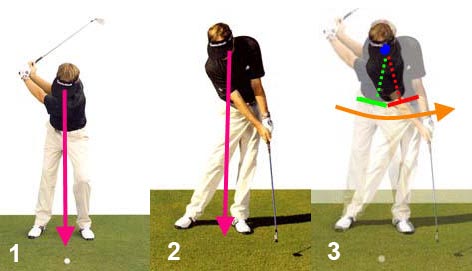 Consider the movements of the lower body and spine in the S&T swing. Image 1 shows a S&T golfer at the end-backswing position. The pink arrowed line shows that the shoulder center (upper swing center) is vertically over the ball. Note that the upper torso has leftwards-tilt and note that the right pelvis is higher than the left pelvis. Image 2 shows a S&T golfer in the early followthrough (immediately post-impact). Note that he has kept the shoulder center (upper swing center) stationary - the pink arrowed line hasn't moved (relative to the left foot and ball position). Note that the pelvis has shifted far to the left - note that the outer border of the left pelvis is a few inches outside the outer border of the left foot. Also, note that the left pelvis is now a few inches higher than the right pelvis. Image 3 - I used the Adobe Photoshop program to make image 2 proportionately smaller in size, so that I could superimpose image 2 over image 1 to produce a composite image (consisting of image 1 and image 2). This composite image gives one a good impression of how much the lower body moves in a S&T downswing. The blue dot represents the shoulder center (upper swing center) and one can see that it essentially remains stationary during the downswing. The green dotted line shows the spine tilt at the end-backswing position, and the red dotted line shows the spine tilt immediately post-impact. The change in spine tilt angle (as seen from face-on) is due to the aggressive left-lateral pelvic shift motion - represented by the curved orange arrowed line. I made the orange arrowed line curved to show that the pelvis not only moves left-laterally - the pelvis also changes its tilt-angle from being right-uptilted at the start of the downswing (solid green line) to being left-uptilted (solid red line) at impact. Jeff. Actually Andy's swing but semantics I guess  A few points: 1. The upper torso at P4 (top of backswing) does not have target-ward tilt. It is virtually vertical with lateral flexion of the spine included. 2. In photo 2 the pink arrowed line is marking the head. I do agree that the head has remained stable. Stack and Tilt or whatever method you choose...are you saying that the head should MOVE forward? The head must be stationary and the upper axis stable to create the secondary axis tilt (virtually all good golfers create this tilt one way or another...though some do it incorrectly). 3. In my opinion the green dotted line as referenced in your post is incorrect. For it to be correct the lower COG would have to be exactly where the belt buckle sits. The lower COG is actually somewhere b/w the belt and tailbone (pretty much right on your pink line) in the center of the hips (hard to peg exactly but easy to approximate). This goes to my point in #1 above that the spine is virtually vertical at P4. David Wedzik Golf Evolution |
|
|
|
Post by imperfectgolfer on Feb 9, 2010 11:27:11 GMT -5
iacas I agree that the upper swing center is stacked over the lower swing center at address and at the end-backswing position, and that gives one the impression that the spine is vertical. However, it is not vertical - it only the "apparent" spine, which is defined as an imaginary line that joints the lower and upper swing center that is vertical. The spine is slightly left-tilted in a spiral between those points. During the backswing, Bennett/Plummer state the a golfer must tilt 30 degrees leftwards after extending the spine, and then bend forward over the waist. That gives a viewer, who is viewing the golfer from the front, an impression that the spine is not left-tilted because the golfer is stacked. Here is the photo from the S&T book. 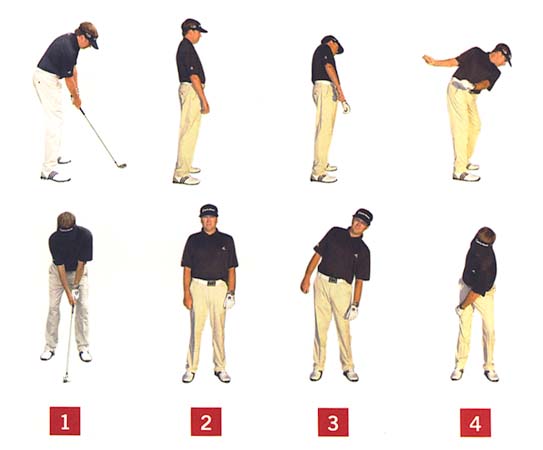 In image 4, the golfer looks stacked (vertically oriented), but incorporated into that posture is a 30 degrees leftwards spinal tilt. Part of that end-backswing stacked posture is the fact that the right leg is straightened and the right pelvis elevated. That causes the lower lumbar spine to be tilted leftwards. Here is a back view of Mike Bennett. 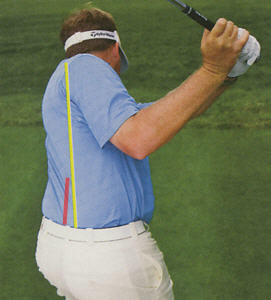 The yellow line represents the leftwards spinal tilt. The red line represents the portion of the yellow line that incorporates the lumbar vertebra. Here is a back view of a conventional golfer - Nick Faldo. 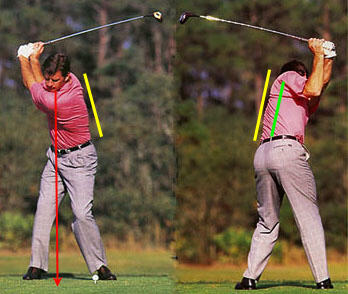 The green line represents the rightwards spinal tilt. There is a major difference to the S&T golfer's spinal orientation. You wrote-: "The hips moves no more or less than the hips of virtually every good golfer out there, regardless of swing style." It is true that many traditional/conventional golfers have a lot of left-lateral pelvic slide in the downswing. That's not the issue. The issue is that a S&T golfer slides the pelvis aggressively left-laterally while keeping the upper swing center stationary. If the upper swing center is kept stationary it immobilises the upper thoracic spine and forces most of the left-lateral latriflexion forces to operate at the level of the lower spine. That's the problem. The anatomy of the lumbar vertebra is not designed for a latriflexion motion. Here is Tiger's downswing.  He has a significant amount of left-lateral pelvic motion in his downswing action. However, it is part of a rotary pelvic motion and he allows his upper thoracic spine to rotate naturally. Note that his spine is rightwards tilted throughout the downswing, and there is no sudden transition from a leftwards tilted spine-to-a-rightwards tilted spine (as occurs in the S&T swing). Tiger's lumbar spine is not being subjected to excessive latriflexion forces in his downswing - as a result of the left-lateral pelvic slide motion. See this S&T drill. www.youtube.com/watch?v=F0qw0r7pDQUNote how David's drill keeps the upper swing center behind (in place) during the followthrough while tucking the butt (aggressively pushing the pelvis forward in the direction of the target). If you do not believe that this swing pattern subjects the lumbar spine to a lot of latriflexion forces, then we perceive reality differently. In the traditional/conventional golf swing, the golfer is encouraged to allow his upper torso to move forward with the pelvis, so that the golfer ends up with an erect posture. Jeff. |
|
|
|
Post by gmbtempe on Feb 9, 2010 11:29:46 GMT -5
iacas,
When I got into the pattern a little bit I worked with a young man in my area just to get the basics, he is not a professional but pga student and has worked with Nick Clearwater and Dan Carraher(iteach) on the pattern, not sure you are familiar with either of them. It was just a basics lesson.
I have said in this thread, or many threads when I make comments on the SnT swing, if I was working consistently with a professional some of the issues I was having probably could be sorted out, unfortunately there is none in Az that I am aware of.
I can't explain the distance issue but I went form 107mph on a launch monitor to 102mph with less carry. I also had similar distance drops, and height drops on every club. Longer irons were not hit high at all. What was interesting though is smash factor was just great on every shot, these were very solid hits with a push draw and push hook pattern. I could easily play the pattern based on the contact.
What was most disconcerting was that every so often through the course of a practice session I would hit shanks. It would be totally random as well, not like you hit one and there goes the confidence kind of thing. I had no faith it would not happen on the course so could never put the pattern in play.
This stuff about the back, I don't have the best back in the work and I never felt as much as a twinge in my back.
Another thing that concerns me, and this is relative to my own faults is that the hands seem to go inside and well behind the body to my untrained eye. In my swing the body tends to outrace the hands pretty badly, wouldn't this problem just be exacerbated in the SnT swing?
I could totally see myself giving the pattern more time and effort, my current instruction uses very similar approaches and is based off TGM, darome.
|
|
|
|
Post by imperfectgolfer on Feb 9, 2010 11:44:29 GMT -5
David, You are assuming that the fact that a S&T golfer has a lot of extension of the torso in his address/backswing swing pattern that it causes the intervertebral discs to be less compressed. Thats very likely true. However, I know of no biomechanical reason that variable degrees of spinal compression in a golf swing would damage the spine. It is not as if a golfer is lifting heavy weights eg. lifting a 100-150 lb rock from a bent-over posture. The reason why I think that the S&T golfer puts his lumbar spine at risk is the fact that most of the left-laterally directed spinal forces are operating at the level of the lower spine - because the upper thoracic spine is kept stationary during the swing. The lumbar vertebra are not anatomically designed for any latriflexion motions. 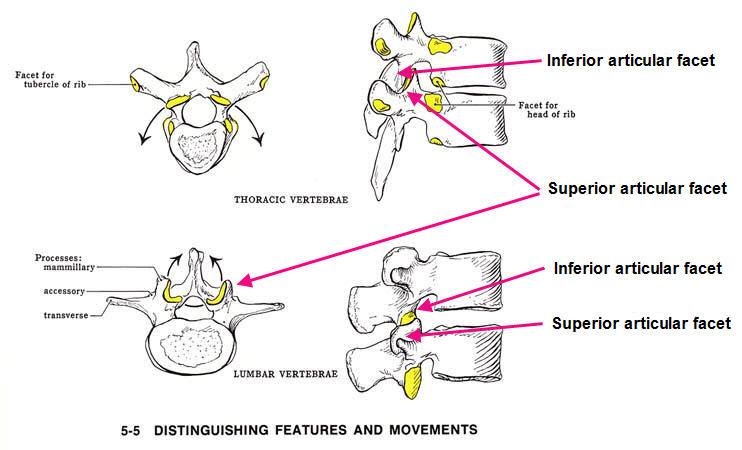 The lumbar articular facet joints are cup-shaped (ball-and-socket type) joints, that only allow motion in a sagittal (vertical) plane. Regarding this photo.  I drew the dotted lines from the upper swing center to the lower swing center. It is true that they do not perfectly represent the actual degree of spinal tilt - the "true" spine is much more centralised in both the end-backswing and followthrough photos. However, it is also "true" that most of the latriflexion spinal motions are occurring at the level of the lower spine - because the upper swing center is kept stationary. Jeff. |
|
|
|
Post by imperfectgolfer on Feb 9, 2010 12:09:31 GMT -5
Greg, I am not personally surprised to learn that many golfers who try the S&T swing lose distance. I personally believe that the major source of power in a swinger's action is the efficacy of release of PA#4 secondary to a pivot action. In a traditional/conventional swing (eg. Jamie Sadlowski's swing) the left arm can be blasted into orbit as the upper torso uncoils. I think that the upper torso's speed of uncoiling can be much more efficient when the shoulders move in the same rotational plane as the rotating upper torso.  Note how horizontally Jamie's shoulders rotate in the early downswing. By contrast, the shoulders in a S&T swing move in a more ferris-wheel manner (up-and-down manner) and I believe that the speed/efficacy of torso motion is more optimal when the upper torso rotates more horizontally in the early-mid downswing (prior to the release of PA#4) - like Ben Hogan in this next swing video. www.youtube.com/watch?v=_AmPuzgBXEMI think that Hogan's torso motion is both biomechanically natural and highly efficient. His shoulders rotate relatively horizontally around his rightwards tilted spine. Jeff. |
|
|
|
Post by gmbtempe on Feb 9, 2010 12:32:10 GMT -5
I think Hogan is just about perfect, I just wonder if his perfection transfers well to the golfing masses, what is the average handicap in the U.S., 25? I don't think that person is every going to come close to the right impact alignments, thats where I do think there is some validity to the SnT method.
There are some before and after videos from Dan Carrehan and others on Youtube that show it can be very effective in taking people who can't make good contact and get them much closer to a position to actually make consistent contact, in a very short period of time.
I have a friend at my office who I have worked with, we have fixed his grip, his stance, backswing and downswing with some improvements but he still cant get any low point consistency and his handicap is only marginally better. I told him I want to use him as a test using the SnT pattern to see what would happen with a 25 handicap.
|
|
|
|
Post by imperfectgolfer on Feb 9, 2010 12:45:33 GMT -5
Greg, I would not be surprised to learn that teaching that 25 handicap golfer a S&T swing would result in better consistency in low point location. However, I think that one could get the same good results with a more centralised backswing action. 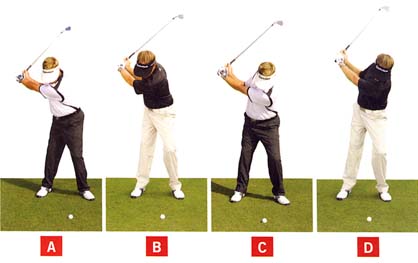 Image c represents the S&T end-backswing posture while image b represents a rightwards-centralised backswing golfer's end-backswing posture (eg. Stuart Appleby). A vertical end-backswing posture would be intermediate between b and c (eg. Sean O'Hair), and that should also result in better consistency in low point location - without subjecting the spine to excessive latriflexion forces. Jeff. |
|
davidwedzik
Beat up Radials
 3Jack Top 50 Instructor
3Jack Top 50 Instructor
Posts: 26
|
Post by davidwedzik on Feb 9, 2010 12:45:47 GMT -5
See this S&T drill. www.youtube.com/watch?v=F0qw0r7pDQUNote how David's drill keeps the upper swing center behind (in place) during the followthrough while tucking the butt (aggressively pushing the pelvis forward in the direction of the target). If you do not believe that this swing pattern subjects the lumbar spine to a lot of latriflexion forces, then we perceive reality differently. In the traditional/conventional golf swing, the golfer is encouraged to allow his upper torso to move forward with the pelvis, so that the golfer ends up with an erect posture. Jeff. Remember...the drill is just that...a drill...in the actual swing motion the upper center does move forward very slightly as it extends through impact and the head goes with it (a bit) into finish. This drill is meant for people that do not keep their head stationary and stay in flexion throughout the downswing into impact. The look shown there is exaggerated a bit to get the sensation across...that is really the point. The other thing to note is that the "arched" look is more extreme due to the relative angle the viewer is seeing the position just past impact from (because a golfer is rotating at this point we would need to move the camera along with the rotation to see it all correctly. If this were done you could notice the right side lateral tilt of the spine as well). Dave |
|
davidwedzik
Beat up Radials
 3Jack Top 50 Instructor
3Jack Top 50 Instructor
Posts: 26
|
Post by davidwedzik on Feb 9, 2010 12:56:47 GMT -5
Here is a back view of Mike Bennett.  The yellow line represents the leftwards spinal tilt. The red line represents the portion of the yellow line that incorporates the lumbar vertebra. Here is a back view of a conventional golfer - Nick Faldo.  The green line represents the rightwards spinal tilt. There is a major difference to the S&T golfer's spinal orientation. I actually like your photos here - IMO this shows the spine being virtually vertical in the photo of Andy (I say virtually because this is a posed photo...if you look at one of the SnT players in an actual swing you would see vertical). At the same time it shows Nick Faldo in a position that (to me) adds a "whole-nother" dimension to the return to impact. This goes to the point of tilting to the left while turning the shoulders and extending...we would say to do so in order to turn the shoulders in a circle and keep the upper and lower centers stacked (vertical). *** In another of your posts you mention Sean O'Hair's top of backswing position as somewhere b/w SnT and Nick Faldo. I would say that Sean O'Hair's top of backswing position is as close to the SnT model as anyone out there (Mike/Andy agree also). To me this is where a lot of the problem comes in...as soon as someone says SnT it is seen as extreme or radical...but say Sean O'Hair (for example) and people say "wonderful", "best on tour", etc. Dave |
|
|
|
Post by Richie3Jack on Feb 9, 2010 13:23:33 GMT -5
Dave, welcome to the forum!
I think you will find that this is a S&T friendly forum in that we encourage golfers and instructors to share their thoughts on the S&T...good or bad. Just like we encourage golfers and instructors to share their thoughts on TGM, darome, etc...good or bad.
I agree with your thoughts on S&T in that once that stigma of S&T is attached to a swing, it's often automatically viewed in a negative way and I don't think it's quite fair or accurate that some people do that.
When I created this forum, one of the things I had in mind was the S&T and to provide a place for S&T'ers to discuss the pattern and essentially provide information about the pattern and then let the other members truly decide for themselves. This applies to any form of golf instruction (TGM, darome, Hardy 1 Plane, Jimmy Ballard, etc), equipment, architecture, etc philosophies. So others like Dana, Logan, Steve Sieracki, Nick Clearwater, etc. are more than welcome to join the board and should feel at ease at expressing their views on S&T or anything in golf...even if they disagree with my opinion.
I'll just reiterate this to any current member or any people thinking of becoming a member of this forum. Any opinion is more than welcome on this board as long as it's backed up with facts and/or logic and reason. All we ask is to void insults and condescending tones. So far we have had zero problem with this and if there is a problem, please notify me via PM and I will investigate the matter.
Thanks again,
3JACK
|
|

